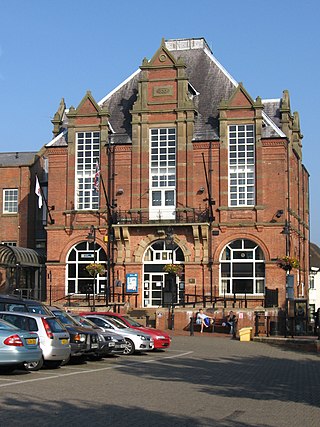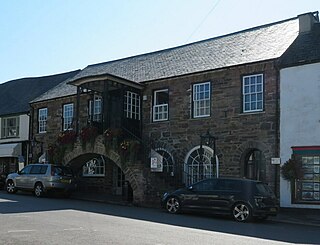
Leigh Town Hall is a municipal building in Leigh, Greater Manchester, England. It stands in Civic Square at the junction with Market Street, facing Leigh parish church. It was built in 1907 and granted grade II listed building status in 1987.

The Crescent is a street in Taunton, a town in the English county of Somerset. Construction began in 1807, during a period of extensive redevelopment in the town, driven by the Market House Society and the Member of Parliament Sir Benjamin Hammet. Lined on the eastern side by a Georgian terrace, the street follows a shallow crescent shape, broken in the middle by Crescent Way and a bit further south by St George's Place. It links Upper High Street, at its southern end, with Park Street and Tower Street to the north. On the western side, Somerset County Council have their offices in the County Hall, erected in 1935, and extended in the 1960s. The Georgian terrace, the Masonic Hall, and the County Hall are recorded in the National Heritage List for England as listed buildings.

Corn exchanges are distinct buildings which were originally created as a venue for corn merchants to meet and arrange pricing with farmers for the sale of wheat, barley, and other corn crops. The word "corn" in British English denotes all cereal grains, such as wheat and barley. With the repeal of the Corn Laws in 1846, a large number of corn exchanges were built in England, particularly in the corn-growing areas of Eastern England.

Ripley Town Hall is a municipal building in the Market Place, Ripley, Derbyshire, England. The town hall is the headquarters of Amber Valley Borough Council.

Melksham Town Hall is a municipal building in the Market Place in Melksham, Wiltshire, England. The structure, which was built as a cheese market and is now the home of Melksham Town Council, is a Grade II listed building.

Buckingham Town Hall is a municipal building in the Market Square, Buckingham, Buckinghamshire, England. The structure, which was the meeting place of Buckingham Borough Council, is a Grade II* listed building.

Midsomer Norton Town Hall is a municipal structure at The Island, Midsomer Norton, Somerset, England. The structure, which serves as the meeting place of Midsomer Norton Town Council, is a Grade II listed building.

Chudleigh Town Hall is a municipal building in Market Way, Chudleigh, Devon, England. The town hall, which is the meeting place of Chudleigh Town Council, is a Grade II listed building.

Garstang Town Hall is a municipal building in the High Street in Garstang, Lancashire, England. The structure, which currently accommodates two shops and a Royal British Legion Club, is a Grade II listed building.

Northallerton Town Hall is a municipal building in the High Street, Northallerton, North Yorkshire, England. The structure, which is the meeting place of Northallerton Town Council, is a grade II listed building.

Helmsley Town Hall is a municipal building in the Market Place in Helmsley, North Yorkshire, England. The structure, which is used as a community library and a community events centre, is a grade II listed building.

Stokesley Town Hall is a municipal building in the Market Place in Stokesley, North Yorkshire, England. The structure, which accommodates the offices and meeting place of Stokesley Town Council, is a grade II listed building.

Clun Town Hall is a municipal building in The Square in Clun, Shropshire, England. The building, which is now used as a museum, is a Grade II* listed building.

Dulverton Town Hall is a municipal building in Fore Street in Dulverton, Somerset, England. The building, which is the meeting place of Dulverton Town Council, is a Grade II listed building.

Fenton Town Hall is a municipal building in Albert Square in Fenton, Staffordshire, England. It is now occupied by local businesses, a café and an art gallery.

The Moot Hall is a municipal building in Market Cross Place in Aldeburgh, Suffolk, England. The building, which is the meeting place of Aldeburgh Town Council, is a Grade I listed building.

The Old Town Hall is a municipal building in the High Street in Needham Market, Suffolk, England. The building, which now accommodates an antiques centre and other shops, is a Grade II listed building.

Hadleigh Town Hall, also referred to as the New Town Hall, is a municipal building in the Market Place in Hadleigh, Suffolk, England. The building, which is the meeting place of Hadleigh Town Council, is a Grade II listed building.

Leconfield Hall, formerly Petworth Town Hall, is a municipal building in the Market Square in Petworth, West Sussex, England. The building, which is now used as a cinema, is a Grade II* listed building.

The Old Town Hall is a municipal building in the Market Place in Wilton, Wiltshire, England. The structure, which is currently used as a Baptist church, is a Grade II listed building.





















